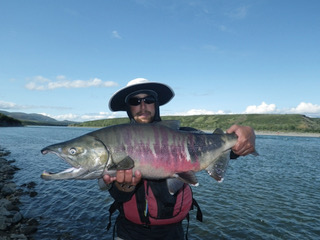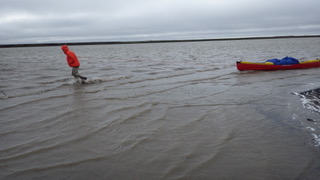Bob O'Hara is a legendary expedition canoeist based in the Minneapolis-St. Paul area. He's been leading weeks- and months-long canoe expeditions into the Arctic and far north since the late 1960s and is known for his meticulous research and preparation.
Bob has also gained a reputation as a great mentor and resource for anyone planning their own Arctic canoe expedition. I was happy to again chat with Bob at a recent outdoor expo and hear his talk on planning and preparing for a wilderness expedition. Bob agreed to share his expedition planning tips (below) here on Bull Moose Patrol. Be sure to check out our previous interview with Bob here.
EXPEDITION BOUND: Canoe Travel in the Far North
prepared by: Bob O’Hara
Grizzly spotted on the Noatak River. Photo courtesy of Bob O'Hara.
1. BEGINNING: Selecting an area or river
—Dream and focus on what you really want to do and DREAM BIG!!
—Research, inquire—seek out others with knowledge, develop a time line (the Internet has an immense amount of info)
—Plan, plan, and more PLANNING!!
—Follow your plan
—Enjoy your trip, have fun, fulfill your dreams
—Record your experience with a journal, photos, video, etc., so that you may be a future source to others for their trip
Packing a canoe on the Colville. Photo courtesy of Bob O'Hara.
2. CONCERNS: These need to addressed early in the planning stages
—Money (this will dictate and be your most limiting factor)
—Crew (their experience must match the trip's level of difficulty)
—Equipment (determine what to bring, in good repair, know how to use)
—Time (be extremely realistic about how long this trip will take (e.g., river vs. lake travel))
—Emergencies and safety (have a back-up plan/route; include one or more PLB, Spot or In Reach, Sat phone; pack a first aid kit that works (see your doctor))
Camping on the Colville. Photo courtesy of Bob O'Hara.
3. HAZARDS/HARDSHIPS
—Weather: wind, temperature, ice, long daylight, UV light
—Bugs: as in plural, plan for the very worst, hope for the best
—Water: rapids, water levels, water temp (hypothermia), portages
—Time away from home: for many, it may/will alter behavior
—Physical demands: be realistic on what your crew can handle safely
—Navigation: pick the prudent route, stay found
Headwaters of the Noatak River. Photo courtesy of Bob O'Hara.
4. ROUTES
—Selection: choose a route that is practical for your time, experience, money
—Maps: use them, take extra, different scales, plan an escape route (also use new maps—plastic paper)
—Knowledge: know the route, drops per mile in a chosen river, kinds and amount of rapids, kinds and number of lakes, prevailing wind direction, portages (length and potential number of trips per person)
Salmon on the Noatak River. Photo courtesy of Bob O'Hara.
5. CREW SELECTION
—Different skills and duplication of skills
—Develop techniques to maintain compatibility, such as different partners for sleeping, cooking, paddling, etc.
—Everyone needs to have input (decide how to decide on group issues)
—Understand commitment, how you measure it, when you make it, when you break it (remember that money binds, talk is cheap)
—Discuss concerns early on, develop clear communication and be sure everyone is using the same terminology
—Keep a positive attitude
—Be aware of the generation gap, if present, and if it will impact your trip
—Gender differences do exist, but with awareness they will not impact the group or your trip; work toward individual strengths
Photo courtesy of Bob O'Hara.
6. STRESS
—It will occur
—Develop/practice coping techniques to use in stressful situations
—Prevent as much as possible: rotate duties, share feelings, be honest, have a library, take time out/off, don’t bite off more than you can chew
—Keep people moving safely, dry, warm, and well nourished
—Breaking up or going separate ways is common after a trip, so plan for it
—Be aware of the mad dash out syndrome. Crew members may want to shorten the trip, skip some sights, paddle longer each day, only to regret these actions when the trip is finished or break up the group into sub groups to finish.
Packing and shipping gear in advance for the Noatak River trip. Photo courtesy of Bob O'Hara.
7. EQUIPMENT
—Checklists: use them all of the time, be all inclusive
—Duplication of key items: you must have emergency back-up items on board
—Quality matters: discard the old and be careful with imitations
—Adaptation: old and tried vs. new (when do you make a change?)
—Good equipment: your first line of defense for safety—stay alive!
—Coordinate equipment with its intended use. The Arctic and far north are neither the BWCA nor a Southern River. Listen to the people who have gone before and plan accordingly. You may have to change/substitute some of your favorite equipment.
At the Colville headwaters, using a Cessna 206 for two paddlers and gear. Photo courtesy of Bob O'Hara.
8. GETTING THERE AND BACK
—Border crossing (Canada): know the rules and the penalties (no felons allowed in Canada)
—Shipping gear: May be necessary to ship prior to trip, so confirm its arrival (may need an expeditor to clear customs)
—Taking everything with you is a guarantee that everything goes
—Locate a route in and a reasonable route out. Have a way out!
—Have identification with you, the more the better: picture I.D., passport, birth certificate—some or all will be necessary. A major credit card(s) is essential. VISA is still the most recognized across all of Canada. Inform your bank before you leave.
—Search and rescue: when do you have it implemented, who does it, who pays? If you can’t afford it, do you belong in the north? Consider travel/evacuation insurance.
—Medical insurance: Have identification numbers, be prepared to pay (Note: Medicare does not cover Canada; you may need a supplemental policy for trip duration)
—Medication: waterproof container, include a back-up supply in a separate canoe or in a different pack
—Register with the authorities or others before final departure (RCMP or similar)
—Serendipity saved many an expedition, but not all. Plan to be self-sufficient. Don’t plan on crying wolf—no one may hear you!!
—On commercial air flights:
When is a stove not a stove—when its burner head and fuel tank are NOT attached
No stove fuel (gas) allowed
No pepper spray allowed
Shotgun or rife with trigger guard, in locked case
Ammunition in locked box/container not in the gun case—limited amount allowed
REMEMBER:
No one ever drowned on a portage!
There is no free lunch—plan to pay your way
If you want to rough it, put sandpaper in the seat of your pants
Keep the round side down
Necessity is the mother of invention (bring duct tape and super glue)
A stitch in time saves nine—check all equipment/clothing before leaving
Nature bats last!!! Always.
HAVE A DREAM — LIVE IT
SET A GOAL — ACHIEVE IT
You Might Also Want to Check Out:











I had a fun conversation with White Bear Lake magazine about why I started Bull Moose Patrol, leading wilderness trips, and why I never tire of sharing my love of the outdoors or introducing outdoor experiences to people that they may have never imagined!